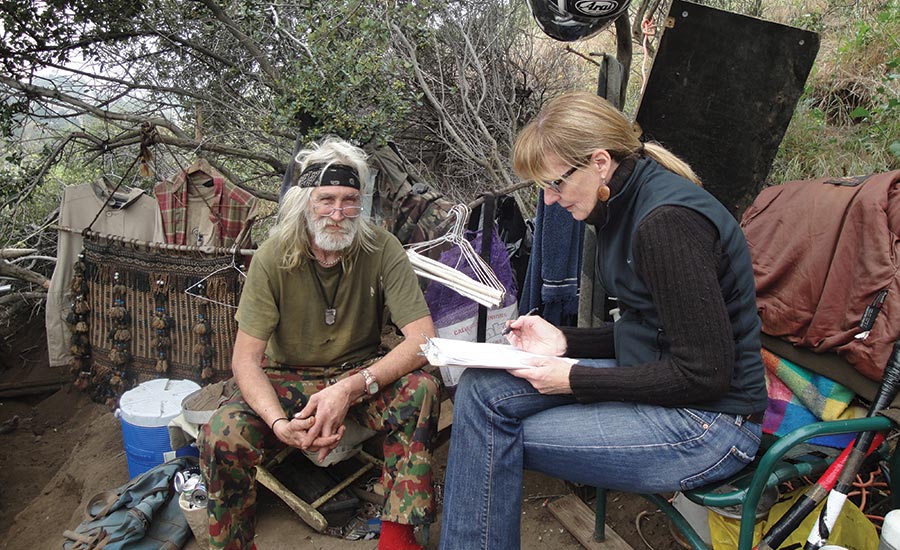Rosanne Haggerty opened Common Ground in 1990; it has become one of the nation’s most successful builders of insightfully designed housing, with supportive services for the formerly homeless. Ten years ago, she founded the nonprofit Community Solutions and began to show how homelessness is a solvable problem using her organization’s systematic, data-driven approach (RECORD, March 2013 and October 2018). One component of the organization is Built for Zero, a network of 89 communities pledged to end homelessness by aligning government agencies, policies, and mission-driven nonprofits so that there is a clear path and a community-wide commitment “to bringing every person home.”
Haggerty is a former MacArthur Foundation “genius grant” recipient; last April, the Foundation dramatically upped the ante by awarding Community Solutions the extraordinary sum of $100 million through its 100&Change program to advance the goal of ending homelessness in participating communities in five years. RECORD contributing editor James Russell spoke to Haggerty about the potential of such a grant, and of her work now as the pandemic threatens mass evictions.
You bring together government agencies and nonprofit organizations to develop a clear vision, relying on extensive data. How is this different from the way many cities confront homelessness?
When we were developing housing at Common Ground, we realized the need was to change the way problems are solved and the way organizations worked together. As we were building, we saw the problem was worsening. [That organization, now called Breaking Ground, continues its work.]
We asked why so many efforts fail to reduce homelessness and concluded that the people who are supposed to help don’t have the information they need. Even before Covid, the country spent $12 billion annually reacting to this lack of housing. To solve any complex program, you need to understand it, how it is moving and changing, and everyone must be on the same page. The point-in-time count—an attempt by cities to enumerate everyone without shelter— is usually done once a year, in January, and has long been the data standard. Yet it’s inaccurate, misleading, and hard to act upon.
Community Solutions helps cities and counties build an operating system, using data, to align their activities and understand what they need to do. When you know by name the people affected, you know how to get results—when to invest in housing or how to shift subsidies and other policies. Officials don’t know what part of the solution is housing supply until they get their arms around the entire problem.
Has the model proved to be resilient during Covid?
In our 89 communities in Built for Zero, 14 have achieved functionally zero homelessness and another 40 made reductions, even through Covid.
Can you really track all the people lacking stable housing?
We’re starting with the information communities already have: the age, military veteran status, all the characteristics that allow people to qualify for different housing resources. You look at individuals. Who is new to homelessness? Why did this person return to homelessness? That gives the opportunity to do qualitative interviewing where you can ask what kinds of resources are needed. You can catch early signs of problems that affect a number of people and formulate preventive programs.
Have you seen a big rise in homelessness during the pandemic?
Eviction moratoriums have been vital in keeping numbers down. The federal moratorium, which expired at the end of July, has been partially extended [at press time]. But there are impressive resources available to communities to avoid eviction. Congress has committed $51.5 billion in emergency rental assistance and an additional $5 billion to help people who are currently homeless. The challenge is getting the resources to those who need them.
What does the MacArthur Foundation grant make possible?
It allows us to operate on all cylinders for the next five years. It will enable us to expand to 110 communities, to expand our policy advocacy to clear the path of dated policies, and to promote funding incentives to bring about large-scale reductions in homelessness.
Isn’t a huge increase in affordable housing essential in the country’s most expensive cities with the most visible homeless problems?
I was impressed by a presentation I saw by Gainesville, Florida, officials. Determined to reduce homelessness, they changed zoning to streamline access to hotels that could be quickly converted for housing. They dealt with barriers within their grasp—ones that elsewhere cause delays, delays, and delays—and so created new housing and seized opportunities.
You say part of the MacArthur grant could be used to advocate changes in federal policy. Are you hoping to make more affordable housing available for everyone in need, not just the homeless?
All the levers intended to improve affordability are disconnected. Communities, states, and the national government must realize all kinds of disparate activities are at cross purposes and therefore achieve limited results. There are dozens of requirements, zoning impediments, and funding hoops. That an affordable-housing developer has to go to 10 or more different funding sources is insane. Homelessness is not the problem, it’s a symptom of the broken housing-production system.
Is that the reason Community Solutions finances its projects with a “social-impact model” that draws on private philanthropy?
Yes. We use these much nimbler capital sources to get projects built faster.
How do you make the entire spectrum of housing production, finance, and regulation work?
Understanding the whole system is key. Cities have eviction policies, so how come people are still being evicted? In city after city, veterans walk around with a federal housing voucher [rent subsidy] and they can’t find housing. You can educate landlords differently, enforce fair-housing laws differently. All those opportunities get buried if all you see is a homeless issue.
During Covid, we have done three conversion projects. Speed is important to get ahead of other investors competing for these properties. We successfully repurposed the Santa Fe Suites, a 120-room extended-stay hotel, to house a variety of residents with precarious housing situations. Another example is Centra Villa in Atlanta, an aging 132-unit apartment complex that has been renovated for veterans with a mix of incomes. And we’ve converted a shelter for homeless veterans in Detroit into permanent supportive housing.
California has the least affordable markets in the country. But you admire its Homekey program. Why?
Homekey created a substantial pool of $600 million in funding and is waiving notorious environmental-review statutes that slow up housing enormously. You’ve got to address the factors that can completely thwart housing-affordability aspirations. They were able to quickly acquire some 6,000 units and turned them into permanent affordable housing.

Outreach worker Kerry Morrison surveys a homeless man in Hollywood, California, for a Community Solutions initiative. Photo © Rudy Salinas, click to enlarge.
How should architects be involved?
Architects need to step up and show that homeless housing is not automatically a negative if it is a thoughtful, contextual building. In that role, they can allay fears of proposed new projects.
Architects need to go to the community meetings. Too often the debate is dominated by those who are more vocal and organized in shouting down a project. All of us should be invested in a housing system that makes our communities open and flexible, well designed, and inclusive. If we don’t do that work, we leave the field to the naysayers.
What should America’s overarching housing goals be?
We would be in a different place if every community understood that their housing policy should include ending homelessness. And no one should be paying more than 30 percent of their income for safe and healthy housing.

 The MacArthur grant enables us to expand to 110 communities, clear the path of dated policies, and to promote funding incentives to bring about large-scale reductions in homelessness.
The MacArthur grant enables us to expand to 110 communities, clear the path of dated policies, and to promote funding incentives to bring about large-scale reductions in homelessness.


Post a comment to this article
Report Abusive Comment